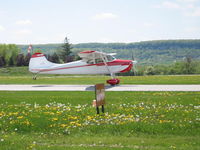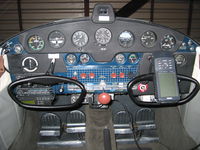Electrical/radio question
Moderators: GAHorn, Karl Towle, Bruce Fenstermacher
Electrical/radio question
For you electrical gurus; I'm doing an avionics stack (GMA 347, KX165 w/GS & KI-206 indicator, KY197 and KT78). The shop is handling the paperwork for the wiring, I'm doing the fabrication stuff and the actual installation. I was planning to use the original pull-type radio switch but the radio guy say he's seen them smoke before and suggested installing a relay to handle the current draw. Anyone know how many amps those original switches are rated for? The new circuit breakers - for what it's worth - added together total 29 amps but even with both xmitters keyed simultaneously and all the other devices powered, I can't imagine more than about a 20 amp draw. But admittedly I could be way off...anyone have the solution? thanks.
Greg Anderson
'55 170B N4316B
'55 170B N4316B
- cessna170bdriver
- Posts: 4063
- Joined: Mon Apr 22, 2002 5:13 pm
Greg,
The sum of the breakers on the radio bus doesn't mean much. The purpose of the circuit protection devices like fuses or circuit breakers is to protect wiring and switches down stream of the fuse or breaker, not to protect the component being powered, so the breaker is rated significantly higher than the actual current draw. The radio fuse (in late B-models at least) is 15 amps, so the radio master switch should be rated at least that high. You may be able to get the actual rating from the IPC, or possibly off of the switch itself. Get the spec sheets for all the components on the radio bus and add up the actual current draw to determine whether you are within the rating of the switch.
Modern radios don't draw near as much current as they did in the 1950's, so I'd be surprised if you're overloading the switch. My '55 B has a KX-155 navcom, KI-209 Indicator, KMA-24 audio panel, KN-64 DME, Apollo 604 Loran, Narco 150 TSO transponder, Narco ADF 140, and a 4-place intercom. I leave all the individual switches on, and turn everything on and off at once with the original radio master switch. I've never had a problem with the switch.
I did have a problem with the very similar nav light switch being intermittent, but a good drenching with contact cleaner solved the problem. (Since I do very little flying requiring nav lights, I suspect the faliure was due to corrosion or dirt on the contacts due to lack of use.) If you determine that your radio load is within the rating of the switch and you are still concerned about the switch due to its age, check the voltage drop across it with everything on. If you see more than one or two tenths of a volt, you may need to clean the contacts or replace the switch. My IPC is at the airport, so I don't have a part number, but I seem to remember that the original switches are available at Hill Aircraft http://www.cessnaparts.com/parts.cfm .
Hope this helps, and let us know how it goes.
Miles
The sum of the breakers on the radio bus doesn't mean much. The purpose of the circuit protection devices like fuses or circuit breakers is to protect wiring and switches down stream of the fuse or breaker, not to protect the component being powered, so the breaker is rated significantly higher than the actual current draw. The radio fuse (in late B-models at least) is 15 amps, so the radio master switch should be rated at least that high. You may be able to get the actual rating from the IPC, or possibly off of the switch itself. Get the spec sheets for all the components on the radio bus and add up the actual current draw to determine whether you are within the rating of the switch.
Modern radios don't draw near as much current as they did in the 1950's, so I'd be surprised if you're overloading the switch. My '55 B has a KX-155 navcom, KI-209 Indicator, KMA-24 audio panel, KN-64 DME, Apollo 604 Loran, Narco 150 TSO transponder, Narco ADF 140, and a 4-place intercom. I leave all the individual switches on, and turn everything on and off at once with the original radio master switch. I've never had a problem with the switch.
I did have a problem with the very similar nav light switch being intermittent, but a good drenching with contact cleaner solved the problem. (Since I do very little flying requiring nav lights, I suspect the faliure was due to corrosion or dirt on the contacts due to lack of use.) If you determine that your radio load is within the rating of the switch and you are still concerned about the switch due to its age, check the voltage drop across it with everything on. If you see more than one or two tenths of a volt, you may need to clean the contacts or replace the switch. My IPC is at the airport, so I don't have a part number, but I seem to remember that the original switches are available at Hill Aircraft http://www.cessnaparts.com/parts.cfm .
Hope this helps, and let us know how it goes.
Miles
Miles
“I envy no man that knows more than myself, but pity them that know less.”
— Thomas Browne
“I envy no man that knows more than myself, but pity them that know less.”
— Thomas Browne
Miles' advice is good, the switches are not likely to cause any problem for you.
But the avionics shop's advice for a relay may have an advantage you haven't considered. A latching relay will indeed place less stress on the switch, but another advantage would be that the relay would be protected by it's own circuit breaker. What this means to you is, an in-flight failure of either the switch OR the relay would normally result in total loss of your avionics. But pulling the circuit-breaker for that relay, would restore your avionics power and you could complete the flight with radios.
(My own airplane has only the switch, but I carry a hand-held backup and portable GPS.)
Just something to consider...
But the avionics shop's advice for a relay may have an advantage you haven't considered. A latching relay will indeed place less stress on the switch, but another advantage would be that the relay would be protected by it's own circuit breaker. What this means to you is, an in-flight failure of either the switch OR the relay would normally result in total loss of your avionics. But pulling the circuit-breaker for that relay, would restore your avionics power and you could complete the flight with radios.
(My own airplane has only the switch, but I carry a hand-held backup and portable GPS.)
Just something to consider...
'53 B-model N146YS SN:25713
50th Anniversary of Flight Model. Winner-Best Original 170B, 100th Anniversary of Flight Convention.
An originality nut (mostly) for the right reasons.
50th Anniversary of Flight Model. Winner-Best Original 170B, 100th Anniversary of Flight Convention.
An originality nut (mostly) for the right reasons.
I confess that at first I was concerned about over radio-ing the airplane (who really needs a Garmin 347 audio panel anyway?), but I got a deal on some of the equipment so what-the-heck. It sounds like you guys have some pretty nice goodies in your planes so if nobody has any horror stories about flames coming from the backside of the panel, I might just keep it simple and use the single switch. The handheld VHF and portable GPS are great suggestions that I plan to follow. Thanks.
Greg Anderson
'55 170B N4316B
'55 170B N4316B
- cessna170bdriver
- Posts: 4063
- Joined: Mon Apr 22, 2002 5:13 pm
I failed to mention earlier that I also carry a KX-99 and, recently, a Garmin handheld GPS. When I had the KX-155 and KMA 24 installed (1991), I had the avionics shop install an interface panel so that I can connect the KX-99 to either a dedicated external stainless rod-type comm antenna or to the nav antenna via a splitter. They also provided a jack on the panel to connect the KX-99 to COMM 2 on the audio panel. I also keep an adapter in the glove box so I can connect the headset and PTT directly to the KX-99. Between the time my old Narco MK12 died and when I had the 155 installed, the KX-99 was my sole navcomm. With the external antenna I could communicate air to ground over a range of about 50 miles.
Miles
Miles
Miles
“I envy no man that knows more than myself, but pity them that know less.”
— Thomas Browne
“I envy no man that knows more than myself, but pity them that know less.”
— Thomas Browne
Yes, the KX-99 (discontinued) is a great radio if you can find one. It has a VOR reciever built in as well, and that's the one I carry also.
Honeywell acquired the Bendix/King avionics line, and they still support most of the stuff. I got worried about future availability of the proprietary battery for the KX-99, so I purchased their alkaline AA-battery pack, and use rechargeables in it. (I use rechargeables in the GPS, KX-99, and the Liightspeed headsets, so I always have plenty of spares charged up and ready.)
Honeywell acquired the Bendix/King avionics line, and they still support most of the stuff. I got worried about future availability of the proprietary battery for the KX-99, so I purchased their alkaline AA-battery pack, and use rechargeables in it. (I use rechargeables in the GPS, KX-99, and the Liightspeed headsets, so I always have plenty of spares charged up and ready.)
'53 B-model N146YS SN:25713
50th Anniversary of Flight Model. Winner-Best Original 170B, 100th Anniversary of Flight Convention.
An originality nut (mostly) for the right reasons.
50th Anniversary of Flight Model. Winner-Best Original 170B, 100th Anniversary of Flight Convention.
An originality nut (mostly) for the right reasons.
I carry an ICOM A22 [radio & vor] with a jack in the panel for the external antenna.
I just have it in case I have any problems with the main units.
John
I just have it in case I have any problems with the main units.
John
John Hess
Past President 2018-2021
President 2016-2018, TIC170A
Vice President 2014-2016, TIC170A
Director 2005-2014, TIC170A
N3833V Flying for Fun
'67 XLH 900 Harley Sportster
EAA Chapter 390 Pres since 2006
K3KNT
Past President 2018-2021
President 2016-2018, TIC170A
Vice President 2014-2016, TIC170A
Director 2005-2014, TIC170A
N3833V Flying for Fun
'67 XLH 900 Harley Sportster
EAA Chapter 390 Pres since 2006
K3KNT
spares
I carry a few spare original fuses, a map and a flashlight.
Just kidding, I also have a Garmin195 in the glove box, in case my Flybuddy 800 LORAN fails!
At night I always carry a handheld comm so that I can turn on the ARCAL runway lights with a failure of my radio/electrical system. The one time I lost my radio was at night, and that handheld made it a "no-brainer".
Cheers Eric
Just kidding, I also have a Garmin195 in the glove box, in case my Flybuddy 800 LORAN fails!
At night I always carry a handheld comm so that I can turn on the ARCAL runway lights with a failure of my radio/electrical system. The one time I lost my radio was at night, and that handheld made it a "no-brainer".
Cheers Eric

